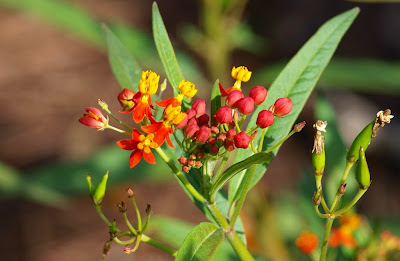Milkweed munching mariposa in Buenos Aires
This is a milkwort, host plant of the famous mariposa butterfly. At Mariposa Grove in California last year (viewing the giant sequoias, Sequiadendron giganteum), Lynda and I were musing on the link between that location name and the butterfly. It turns out the Grove was named after the County which was named after the Creek which was named after the butterflies - the mariposas - that gather in this vicinity each year in May. We call the same butterflies Monarch or Wanderer Butterflies.
In Buenos Aires earlier this year, I encountered the word mariposa again, this time in Jardín Botánico Carlos Thays, that city's botanic garden. This time it was the real thing. The butterflies were living part of their life cycle in a specially planted, and spectacularly successful (at least on the day I was there), butterfly garden.
Most butterfly gardens are inside glasshouses, to keep in the butterflies and perhaps stop the sometimes weedy butterfly attracting plants from escaping. In this case it was possible to grow enough butterfly attracting plants - e.g. lantana - outdoors, and to attract enough wild butterflies.
For the whole time I was in the Buenos Aires butterfly garden - mid-morning on a sunny day after early rain - there enough flitter-flutter to keep the smallest child or easily-amused adult entertained. I even saw a hummingbird, briefly.
The star of the show was the Southern Monarch Butterfly (Danaus erippus, or sometimes Danaus plexippus erippus), present in wing and grub. I gather this is a different species (or sometimes subspecies) to the one we have in Australia, Danaus plexippus, which is also the Monarch Butterfly that flies from Mexico to northern USA each year. That species only arrived in Australia in the 1870s, perhaps (incidentally) by boat, but is now well established in the east and south of the country (and beautifully photographed for Sydney's Royal Botanic Garden Facebook page by Jaime Plaza).
It seems that the southern and northern (American) species both lay eggs under the leaf of the Tropical Milkweed, Asclepias curassavica, but the Southern Monarch Butterfly also favours other species in genus and few others. Here the caterpillar of the Southern Monarch Butterfly is happily nibbling on Tropical Milkweed in the botanic garden of Buenos Aires.
In both species, the eggs hatch to produce a black-and-yellow striped caterpillar that over a fortnight munches its way through as much milkweed as it can, bulking up to 2000 times its original size (along the way shedding its skin five times). After pupating the familiar orange-and-black butterflies emerge to either fly about locally for 2-6 weeks (then dies) or, for specially bred kinds, to migrate up to 3000 kilometres or more (drinking nectar along the way and taking advantage of warm air currents) and live for eight months.
And migrating is something they are famous for. Every spring marioposas arrive in northern USA from overwintering in Mexico and thereabouts. The breeding butterflies I saw in early April in Buenos Aires were presumably short-lived ones enjoying the warmth of the (Southern Hemisphere) autumn. The migratory butterflies are sterile it seems, but for the Southern Monarch Butterfly there is still plenty to learn.
But back to more or less familiar plant territory. Tropical Milkweed is in the family Apocynaceae, well known for including plants with often toxic milky sap. In this species the toxins would kill many animals but not this caterpillar. More than that, the toxins accumulate in the caterpillar and then later the butterfly, making them both toxic to predators.
The fluttering stage feeds on nectar, from the milkweed but also many other flowers. In this case it's a local lantana. Well I say 'local'. It's been planted obviously but I think Lantana camara does naturally around Buenos Aires. As to the origins of the milkweed and the mariposa, I'm less sure.






Comments